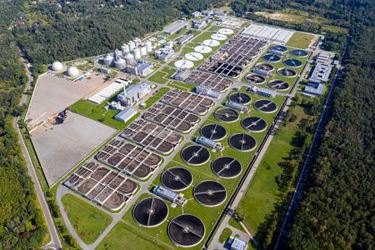Math Solutions Explained: Calculate Food-to-Microorganism (F-M) Ratio

By Daniel Theobald, "Wastewater Dan"

The food-to-microorganism (F-M) ratio is a process control numeric value advantageous to determine the proper number of microorganisms for the biological treatment process. The solution of calculating F-M ratio uses the influent volume of wastewater into an activated sludge system (flow MGD), incoming carbonaceous biochemical oxygen demand (CBOD) (mg/L) concentration into the aeration tank, mixed liquor volatile suspended solids (MLVSS) concentration (mg/L), and quantity (in gallons) of the respective aeration system.
Before illuminating details of the calculation, recognizing the influences of knowing and understanding the mathematics of the F-M ratio result is expressed here.
To a wastewater operator, operating with the F-M ratio out of balance as too low or too high could negatively impact wastewater treatment and potentially cause a wastewater discharge permit violation. So, consequently, the calculation, interpretation, and appropriate corrective action to bring the F-M ratio in balance is favorable in various applications, of which some are signified beneath.
Sludge Wasting
Wasting sludge is an option; however, limitations of changes in F-M from optimal can cause activated sludge to have low affluence of lingering microbiology. The biomass in the activated sludge can be mostly lifeless or ineffective for treatment. In these occurrences, more returned activated sludge will not adequately enhance treatment.
Monitor wasting rate adjustments for improved treatment or consider adding additional biological products.
Adjust Operational Factors
Adjusting an operational factor is a choice; however, changing treated wastewater volume and aeration might not adequately impact F-M to enhance treatability. Operational costs can escalate from running aerators on soaring settings for extended timeframes.
Operational adjustments could include changing the treatment quantity and aeration methods in the wastewater treatment tanks.
Watch the adjustment of operational aspects, as they can be catastrophic. Changes to wasting and treatment volume should only be made after operational direction over days show that a change is mandatory.
Add External Organic Carbon Or Microbiology
Adding external organic carbon or microbiology is an alternative; however, commercial extraneous organic carbon goods can be costly. Methanol products can be dangerous to handle, boosting operational hazards and hindrances. Adding dog food to these systems is inexpensive but can cause concerns with fats, oils, grease aggregation, and toxicity. Consider adding organic carbon to grow substantial treatment biomass.
It is very beneficial to have daily recordings throughout the wastewater treatment documentation. They could include calculations surrounding the F-M ratio.
It is favorable to understand essential wastewater mathematics solution components to become more proficient in calculating F-M ratio, such as: Familiarity with wastewater mathematics effectively reinforces a wastewater operator's career.
Thus, I have created a Calculate F-M Ratio learning animation.
I have also generated a series of wastewater math understanding actions that will broaden with more illustrations of one hour and multiple hours of effort.
This is the Calculate Food-to-Microorganism (F-M) Ratio presentation in my series of “Math Solutions Explained.” If you have specific wastewater math queries, please submit a range of appeals or new challenges.
About Dan Theobald
Known in the industry as “Wastewater Dan,” Daniel L. Theobald, proprietor of Environmental Services (www.esdlt.com), is a professional wastewater and safety consultant/trainer. He has more than 35 years of hands-on industry experience, since 1987, operating many variants of wastewater treatment processing units and is eager to share his knowledge about wastewater with others.
Theobald serves as an active consultant for industries looking to achieve, maintain, and improve discharge permit compliant wastewater treatment at reduced overall cost. He is a Lifetime Member of the Who’s Who Registry of Professionals and holds numerous certifications from wastewater management regulatory boards and professional organizations. Theobald contributed one chapter to the Water Environment Federation’s (www.wef.org) Manual of Practice # 37 (MOP-37), a technical manual resource guide for biological nutrient removal, published in 2013.
